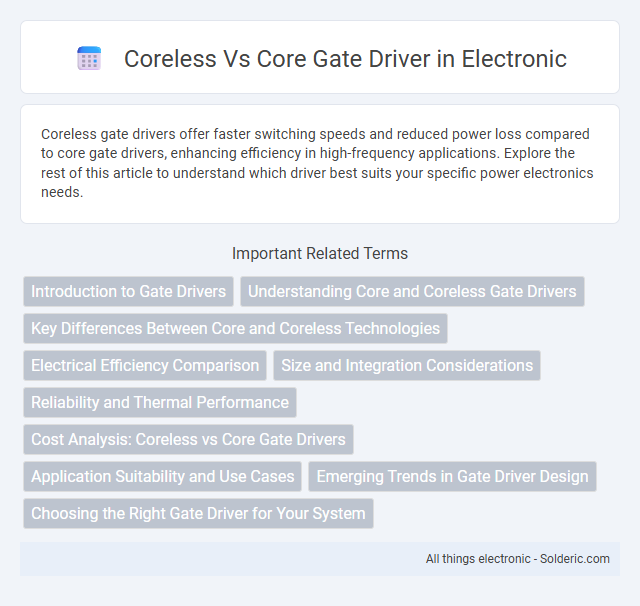Coreless gate drivers offer faster switching speeds and reduced power loss compared to core gate drivers, enhancing efficiency in high-frequency applications. Explore the rest of this article to understand which driver best suits your specific power electronics needs.
Comparison Table
| Feature | Coreless Gate Driver | Core Gate Driver |
|---|---|---|
| Inductive Core | Absent | Present |
| Switching Speed | High, faster switching due to no core saturation | Moderate, limited by core material properties |
| Size & Weight | Compact and lightweight | Bulkier and heavier due to core |
| Efficiency | Higher, minimal losses | Lower, core losses present |
| Magnetic Interference | Lower EMI due to no core magnetism | Higher EMI from magnetic core |
| Cost | Typically higher due to advanced design | Generally lower, mature technology |
| Applications | High-speed, precision power electronics | General-purpose power switching |
Introduction to Gate Drivers
Gate drivers are essential components in power electronics, responsible for switching power transistors like MOSFETs and IGBTs efficiently. Coreless gate drivers utilize integrated circuits without magnetic cores for faster switching and reduced electromagnetic interference, ideal for high-frequency applications. Your choice between coreless and core gate drivers depends on factors such as switching speed, power handling, and system efficiency requirements.
Understanding Core and Coreless Gate Drivers
Core gate drivers incorporate magnetic cores that enhance inductive coupling and energy transfer efficiency, making them ideal for high-frequency switching applications. Coreless gate drivers eliminate these magnetic cores, reducing size and weight while offering improved high-speed performance and reduced electromagnetic interference. Understanding the functional differences helps engineers select the appropriate driver based on power density, switching speed, and electromagnetic compatibility requirements.
Key Differences Between Core and Coreless Technologies
Core gate drivers rely on magnetic cores to transfer energy and regulate switching signals, providing high efficiency but added inductance and size. Coreless gate drivers eliminate the magnetic core, resulting in reduced weight, lower inductance, and faster switching speeds suitable for high-frequency applications. Your choice between core and coreless technologies depends on prioritizing either compactness and speed or energy efficiency and traditional performance.
Electrical Efficiency Comparison
Coreless gate drivers exhibit higher electrical efficiency compared to core gate drivers due to reduced magnetic losses and lower parasitic inductance, which minimize energy dissipation during switching. This efficiency advantage is particularly noticeable at high switching frequencies where core saturation and eddy current losses in core gate drivers significantly degrade performance. As a result, coreless designs enable faster switching speeds and lower heat generation, improving overall power conversion efficiency in power electronics applications.
Size and Integration Considerations
Coreless gate drivers offer a compact design by eliminating the magnetic core, significantly reducing size and enabling easier integration into your densely packed electronic systems. In contrast, core-based gate drivers typically require larger magnetic components, which can increase the overall footprint and complicate PCB layout. Choosing a coreless gate driver enhances design flexibility and supports miniaturization efforts in modern power electronics applications.
Reliability and Thermal Performance
Coreless gate drivers offer enhanced reliability by eliminating magnetic core saturation, which reduces signal distortion and ensures consistent switching performance under varying thermal conditions. Their superior thermal performance stems from lower power loss and compact design, allowing better heat dissipation compared to core-based gate drivers. Choosing a coreless gate driver can improve Your system's longevity and efficiency, especially in high-frequency or high-temperature applications.
Cost Analysis: Coreless vs Core Gate Drivers
Coreless gate drivers typically offer lower upfront costs due to the elimination of magnetic core materials and simpler manufacturing processes, making them cost-effective for high-volume applications. Core gate drivers, while generally more expensive initially due to their magnetic components, provide improved performance in terms of noise immunity and efficiency, which can reduce system-level costs over time. The total cost analysis depends on application requirements, with coreless drivers favored for minimal budget constraints and core gate drivers preferred for long-term reliability and enhanced performance.
Application Suitability and Use Cases
Coreless gate drivers excel in high-frequency switching applications such as RF amplifiers and advanced DC-DC converters, offering minimal core loss and improved efficiency. Core gate drivers are better suited for medium-frequency industrial motor drives and power inverters where robust magnetic coupling and noise immunity are critical. Your choice depends on the specific switching frequency, power level, and electromagnetic interference requirements of the application.
Emerging Trends in Gate Driver Design
Emerging trends in gate driver design highlight a shift towards coreless gate drivers, which offer reduced magnetic losses, compact size, and enhanced high-frequency performance compared to traditional core gate drivers. Coreless designs leverage advanced materials and integrated circuits to improve switching efficiency and thermal management, making them ideal for applications in electric vehicles and renewable energy systems. The ongoing development focuses on optimizing power density and minimizing electromagnetic interference to meet the demands of modern power electronics.
Choosing the Right Gate Driver for Your System
Selecting the right gate driver involves understanding the differences between coreless and core gate drivers, where coreless drivers offer faster switching speeds and reduced electromagnetic interference, ideal for high-frequency applications. Core gate drivers provide enhanced isolation and noise immunity, making them suitable for systems requiring robust protection in harsh environments. Evaluating your system's switching frequency, power requirements, and noise sensitivity ensures optimal performance and reliability when choosing between coreless and core gate drivers.
Coreless vs Core gate driver Infographic

 solderic.com
solderic.com